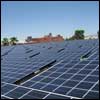The projects selected by the Solar Energy Corporation of India for allocation of 375 MW capacity in the Domestic Content Requirement category under batch I of the second phase of Jawaharlal Nehru National Solar Mission are already facing serious challenges and many of the developers may consider withdrawing unless the Ministry of New and Renewable Energy intervenes.
In a recent letter addressed to Tarun Kapoor, Joint Secretary – MNRE, the National Solar Energy Federation of India said not more than 30 to 35 percent of the projects selected in the DCR category would get executed since the actual domestic cell manufacturing capacity available for the current batch of JNNSM projects was far less than that claimed by domestic cell manufacturers.
“The operational capacity is not more than 100 – 150 MW/annum against the boiler plate/ installed capacity of 500 – 700 MW. Most of the non-operational plants have very limited potential due to vintage equipment and technology and most of the operational capacities have also been unused or lying idle for quite some time,” the letter said, pointing out that many of the domestic cell manufacturing companies did not provide the comfort of continued operations due to corporate debt restructuring and bankruptcy proceedings.
According to the NSEFI, a majority of the cell manufacturers at present have zero production and it would take another two – three months or more to commence production. Even after production commenced, there would be no guarantee with regard to consistency considering the current financial state of the cell manufacturers.
Another challenge before the developers of projects selected in the DCR category was the lack of support from lenders due to perceived quality issues, the NSEFI said in the letter, stressing though that the major concern was cartelization by some of the large domestic cell manufacturers.
“Taking advantage of the procurement compulsions imposed by the Phase II conditions of domestic content, bidding having been completed and strict time limits having been imposed, the manufacturers have increased cell prices by a whopping 6 – 8 cents/Wp within few days of award announcement. This has made the module manufacturers increase the price per Wp by close to 15 – 16 percent than the initial quotes before bidding. This has made DCR projects economically unviable,” the letter said.
The NSEFI said that developers of several projects selected in the DCR category were debating whether to proceed with signing of the Power Purchase Agreement.
“In view of the current cartelization behavior of domestic manufacturers, it has become impossible for developers to execute DCR projects. This is a serious threat to the Solar Mission. It will deter developers for future participation in DCR category,” the letter said.
Proposing that the timeline for implementation in case of projects in DCR category be extended to 24 months from the current 13 months after signing of the PPA, the NSEFI said that such a measure would enable domestic cell manufacturers to wriggle out of the present crisis and commence production, allow more number of projects to be supported by the current manufacturing capacity as well as facilitate setting up of new manufacturing facilities and provide adequate time to lenders to establish the bankability of India manufactured cells and modules.
In the event the challenges facing projects in DCR category were not addressed, the developers should be allowed to withdraw without forfeiture of Earnest Money Deposit or performance bank guarantee, the NSEFI said.
The NSEFI is an umbrella organization of solar manufacturers, solar developers (photovoltaic and thermal), EPC contractors, financial institutions, consultants and other stakeholders.












[…] Read complete article at the original source, you can also read the letter from NSEFI to MNRE here […]